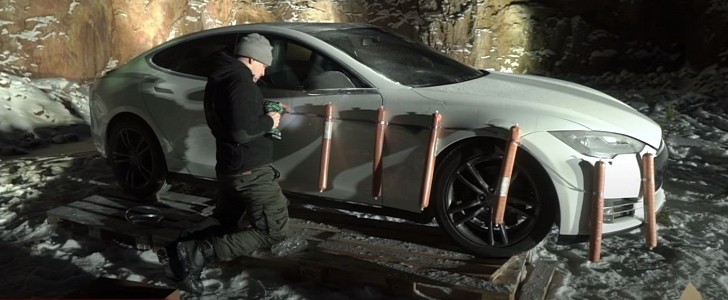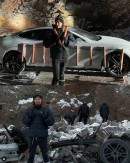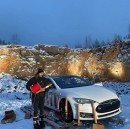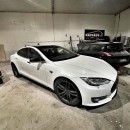We might not all own a Tesla, but most of us do have a smartphone, so we're very much aware of the advantages of having a device that's constantly connected to the Internet.
However, while being able to watch the latest cute cats video at any time is all great, it's worth remembering that connection goes both ways. I'm not going to put my tinfoil hat on nor advise you to do so either, but if some kid was able to track the movements of Elon Musk's private jet, you can imagine it shouldn't be too hard to do the same for average Joes like ourselves. I'm well aware that planes and people are nothing alike and the mechanisms would be different, but the bottom line is that nothing that goes online is 100 percent safe.
Well, that wouldn't be such a big problem if you could control everything your devices send into the ether. If that were the case, whatever got out would have been your doing - and if the information was sensitive, then you only have yourself to blame. But what happens when the companies that make the hardware or the software of your devices start collecting all sorts of data without you having a say in it?
To be entirely fair, we tend to click "accept" with great ease (or is it just me?) without bothering to at least glance over the terms and conditions, so in our hurry, we're most likely giving away a large part of our privacy as well as control over what those companies can do with the information they gathered.
The smartphone industry is probably the best one to illustrate this trend, but as it grows more and more "connected", the automotive one might just be catching up very rapidly. For instance, take Tesla's one-sided decision to remove the lumbar support adjustment feature in the Model Y based on data logs showing customers were barely using it.
"Great," you might say, "that's all done to the benefit of the consumer. Making the vehicle less complex by ignoring features that buyers don't use allows the company to make the manufacturing process leaner and thus reduce the EV's price." Yes, except the Model Y's - as well as all the other Tesla products - price curve looks like something that would make you burn a lot of calories if you were to climb it. In other words, it only goes up. To be fair, the slope could have been ever so slightly steeper if the lumbar support adjustment had stayed, so there's that to consider as well.
Now, though, it sounds like Tesla is preparing to introduce another limitation for its clients, and, funnily enough, this one too concerns the seats. According to @greentheonly, the company is getting ready to roll out a new feature that prevents owners from "abusing" the seat track motor that's used to adjust the position of the seat.
The hacker found the information while browsing through yet hidden code so there's no info on when (or if) this will go live or what exactly constitutes "abuse" in Tesla's view. What the man did reveal was that breaching this unknown threshold would first prompt a warning message reading "Excessive use of seat track motor detected." If the abuser was to ignore the caution, the vehicle should simply deactivate the feature and inform the user via another message: "Seat track motor unavailable due to excessive use." If you were planning on driving the car, you better hope this message catches you in a position that makes this activity possible, because you won't be able to move the seat for the following five minutes ("Wait 5 minutes to adjust seat track position again" reads the message found in the code, according to @greentheonly).
You might be reading this and wondering whether the world has gone insane if something as menial as this is considered newsworthy. Well, it's not so much the feature itself (it'll likely only show up to a handful of people if it gets released) but what it says about how companies are planning to deal with potential problems.
You have to ask yourself: why would Tesla ever consider something like this? Obviously, the motor responsible for shifting the seat back and forth is susceptible to failure, and the last thing Tesla needs right now is to put more stress on its already failing service centers. So, instead of maybe opting for a higher quality motor that can take more punishment (which would add to the steepness of the already mentioned curve), the company decided to prohibit its clients from using the feature as they see fit. Why? Well, because it's easier. And because it can.
"Wait a minute," you might intervene again (you really need to stop doing that), "isn't that ultimately for the good of the client? Does the client want to spend ages waiting for their car to be repaired, or would they rather wait five minutes for control to resume and then only use the buttons as last resort from then on in fear the vehicle would freeze them again?" Well, I don't know because nobody asked them. And herein lies the problem.
This current tendency to nanny the public, to have a higher power taking decisions "for our own good" smells of disguised totalitarianism and needs to stop. We're grown-ups, we can own up to our mistakes and pay for them. The problem is the companies can't. Bring Tesla a malfunctioning seat and ask to have it replaced under warranty and they might pull a log showing you adjusted the damn thing too often, making the warranty void. What is "too often?" Well, go to trial against the company's army of lawyers and you might just find out.
Do you want to warn me against the possibility of overheating the motor? Fine, I appreciate the concern. And I can understand losing the warranty if I continue using it beyond this point. However, locking the seat adjustment system completely to prevent motor failure isn't protecting the owner, but the company. And it's doing so by infringing on the former's rights to use the product they've paid for freely.
There needs to be a limit to the control carmakers have over the vehicles once they've been handed out to their new owners. Otherwise, we should stop referring to these people as "owners" and start calling them "users". To be fair, that's probably where we're headed, but a bit more openness about it and a little less hiding behind the finger would be greatly appreciated.
Well, that wouldn't be such a big problem if you could control everything your devices send into the ether. If that were the case, whatever got out would have been your doing - and if the information was sensitive, then you only have yourself to blame. But what happens when the companies that make the hardware or the software of your devices start collecting all sorts of data without you having a say in it?
To be entirely fair, we tend to click "accept" with great ease (or is it just me?) without bothering to at least glance over the terms and conditions, so in our hurry, we're most likely giving away a large part of our privacy as well as control over what those companies can do with the information they gathered.
The smartphone industry is probably the best one to illustrate this trend, but as it grows more and more "connected", the automotive one might just be catching up very rapidly. For instance, take Tesla's one-sided decision to remove the lumbar support adjustment feature in the Model Y based on data logs showing customers were barely using it.
"Great," you might say, "that's all done to the benefit of the consumer. Making the vehicle less complex by ignoring features that buyers don't use allows the company to make the manufacturing process leaner and thus reduce the EV's price." Yes, except the Model Y's - as well as all the other Tesla products - price curve looks like something that would make you burn a lot of calories if you were to climb it. In other words, it only goes up. To be fair, the slope could have been ever so slightly steeper if the lumbar support adjustment had stayed, so there's that to consider as well.
Now, though, it sounds like Tesla is preparing to introduce another limitation for its clients, and, funnily enough, this one too concerns the seats. According to @greentheonly, the company is getting ready to roll out a new feature that prevents owners from "abusing" the seat track motor that's used to adjust the position of the seat.
The hacker found the information while browsing through yet hidden code so there's no info on when (or if) this will go live or what exactly constitutes "abuse" in Tesla's view. What the man did reveal was that breaching this unknown threshold would first prompt a warning message reading "Excessive use of seat track motor detected." If the abuser was to ignore the caution, the vehicle should simply deactivate the feature and inform the user via another message: "Seat track motor unavailable due to excessive use." If you were planning on driving the car, you better hope this message catches you in a position that makes this activity possible, because you won't be able to move the seat for the following five minutes ("Wait 5 minutes to adjust seat track position again" reads the message found in the code, according to @greentheonly).
You might be reading this and wondering whether the world has gone insane if something as menial as this is considered newsworthy. Well, it's not so much the feature itself (it'll likely only show up to a handful of people if it gets released) but what it says about how companies are planning to deal with potential problems.
You have to ask yourself: why would Tesla ever consider something like this? Obviously, the motor responsible for shifting the seat back and forth is susceptible to failure, and the last thing Tesla needs right now is to put more stress on its already failing service centers. So, instead of maybe opting for a higher quality motor that can take more punishment (which would add to the steepness of the already mentioned curve), the company decided to prohibit its clients from using the feature as they see fit. Why? Well, because it's easier. And because it can.
"Wait a minute," you might intervene again (you really need to stop doing that), "isn't that ultimately for the good of the client? Does the client want to spend ages waiting for their car to be repaired, or would they rather wait five minutes for control to resume and then only use the buttons as last resort from then on in fear the vehicle would freeze them again?" Well, I don't know because nobody asked them. And herein lies the problem.
This current tendency to nanny the public, to have a higher power taking decisions "for our own good" smells of disguised totalitarianism and needs to stop. We're grown-ups, we can own up to our mistakes and pay for them. The problem is the companies can't. Bring Tesla a malfunctioning seat and ask to have it replaced under warranty and they might pull a log showing you adjusted the damn thing too often, making the warranty void. What is "too often?" Well, go to trial against the company's army of lawyers and you might just find out.
Do you want to warn me against the possibility of overheating the motor? Fine, I appreciate the concern. And I can understand losing the warranty if I continue using it beyond this point. However, locking the seat adjustment system completely to prevent motor failure isn't protecting the owner, but the company. And it's doing so by infringing on the former's rights to use the product they've paid for freely.
There needs to be a limit to the control carmakers have over the vehicles once they've been handed out to their new owners. Otherwise, we should stop referring to these people as "owners" and start calling them "users". To be fair, that's probably where we're headed, but a bit more openness about it and a little less hiding behind the finger would be greatly appreciated.
ha, they are also introducing "seat abuse" metrics complete with disabling of seat moving for busers with helpful messages like "Excessive use of seat track motor detected""Seat track motor unavailable due to excessive use" and "Wait 5 minutes to adjust seat track position again"
— green (@greentheonly) January 27, 2022

















